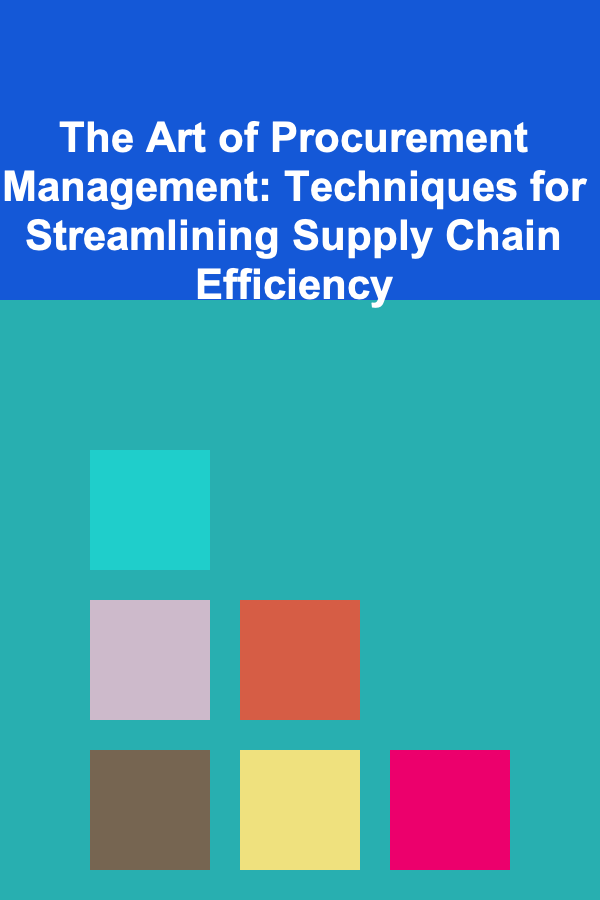
The Art of Procurement Management: Techniques for Streamlining Supply Chain Efficiency
ebook include PDF & Audio bundle (Micro Guide)
$12.99$9.99
Limited Time Offer! Order within the next:

Procurement management is a strategic function within organizations that is integral to maintaining a smooth and cost-efficient supply chain. The procurement process involves the acquisition of goods and services, from identifying needs to sourcing suppliers, negotiating contracts, and managing relationships. With globalization and increasingly complex supply chains, procurement management has become a sophisticated art that demands precision, foresight, and innovation. This guide explores the techniques and best practices that procurement managers can leverage to streamline supply chain efficiency, enhance cost-effectiveness, and foster long-term supplier relationships.
Understanding the Fundamentals of Procurement Management
Procurement management is the backbone of any organization's supply chain. It involves not only the purchasing of goods and services but also ensuring that the process aligns with the company's long-term strategic objectives. Procurement is more than just sourcing; it is a crucial part of the broader supply chain that can impact every aspect of business operations.
a. The Procurement Process
The procurement process typically involves:
- Identifying Needs: Understanding and articulating what products or services are required by different departments within the organization.
- Supplier Selection: Finding the best suppliers that meet cost, quality, and delivery expectations.
- Negotiation: Ensuring favorable pricing, delivery terms, and contract clauses.
- Contract Management: Establishing clear agreements with suppliers that outline terms and performance expectations.
- Supplier Relationship Management (SRM): Ongoing collaboration with suppliers to ensure the smooth delivery of goods and services.
b. The Role of Procurement in Supply Chain Efficiency
A well-managed procurement function plays a vital role in supply chain efficiency by:
- Reducing costs through strategic sourcing and negotiations.
- Ensuring a consistent and high-quality supply of goods and services.
- Minimizing the risk of disruptions due to supplier failures or delays.
- Enhancing collaboration between departments and suppliers to achieve shared goals.
Techniques for Streamlining Procurement Processes
To streamline procurement and improve supply chain efficiency, procurement managers must adopt strategies that reduce inefficiencies, eliminate bottlenecks, and create value for the organization.
a. Automating the Procurement Process
Automation has revolutionized procurement management by reducing manual tasks, increasing efficiency, and improving accuracy. Key automation techniques include:
- E-Procurement Systems: These platforms allow organizations to electronically manage the entire procurement process, from requisition to payment. Features such as digital purchase orders, online catalog browsing, and supplier management reduce paperwork and administrative overhead.
- Automated Requisition and Approval Workflows: By automating requisition approvals and purchase orders, organizations can expedite the purchasing process and minimize delays.
- Supplier Portal Integration: Using a supplier portal where vendors can directly manage orders, deliveries, and invoices helps eliminate errors and facilitates better communication between procurement teams and suppliers.
b. Implementing Strategic Sourcing
Strategic sourcing is an advanced procurement technique that focuses on the long-term relationship between buyers and suppliers. Instead of merely purchasing goods at the lowest price, strategic sourcing seeks to optimize the total cost of ownership over time. Key elements include:
- Supplier Consolidation: Instead of working with numerous small suppliers, consolidation reduces complexity by focusing on a smaller number of reliable, long-term suppliers. This can improve negotiating power and foster stronger relationships.
- Supplier Performance Evaluation: Continuously evaluating supplier performance based on delivery time, quality, and service ensures that procurement decisions are always aligned with business goals.
- Cost Analysis: Conducting in-depth analysis of the total cost, including not only the price of goods but also factors like transportation, handling, and inventory costs. This provides a comprehensive view of the true cost and allows procurement managers to make smarter purchasing decisions.
c. Leveraging Data and Analytics
Data and analytics are crucial for improving procurement decisions and driving supply chain efficiency. Procurement teams should leverage data-driven insights to:
- Predict Demand: Using historical data, procurement managers can forecast future demand more accurately. This enables them to place timely orders and avoid overstocking or stockouts.
- Supplier Risk Assessment: Analyzing supplier financials, delivery history, and geopolitical risk factors can help procurement managers mitigate risks associated with suppliers. Proactive risk management minimizes disruptions in the supply chain.
- Cost Optimization: By analyzing cost data, procurement managers can identify trends, negotiate better prices, and streamline sourcing practices. Analytics can also highlight areas where inefficiencies are leading to increased costs.
d. Adopting Lean Procurement Practices
Lean principles aim to eliminate waste and increase the value delivered to customers. In procurement, lean practices help streamline the supply chain by focusing on value-added activities and minimizing inefficiencies. Key practices include:
- Reducing Inventory Levels: Lean procurement aims to reduce the amount of inventory held by companies, which helps reduce costs associated with storage, handling, and obsolescence. Just-in-time (JIT) inventory systems can be particularly effective in this regard.
- Continuous Improvement: Regularly reviewing and improving procurement processes can help uncover inefficiencies. This includes gathering feedback from suppliers, stakeholders, and internal teams to optimize procurement operations continually.
- Supplier Collaboration: Collaborating with suppliers to identify inefficiencies in the supply chain and implementing joint improvement initiatives can lead to mutual benefits. This could involve sharing forecasts, aligning production schedules, or investing in technology to streamline operations.
e. Centralizing Procurement for Greater Control
Centralizing procurement functions, where applicable, provides better control over the supply chain and allows for greater consistency across different departments. Benefits of centralization include:
- Bulk Purchasing: Consolidating purchases across departments enables organizations to take advantage of bulk buying discounts, reducing overall procurement costs.
- Standardization of Processes: Centralizing procurement creates standardized procedures for purchasing, which improves efficiency and reduces errors.
- Improved Negotiating Power: A centralized procurement function has more leverage in negotiations, enabling better pricing, favorable terms, and improved supplier relationships.
Building Strong Supplier Relationships
Suppliers play an essential role in maintaining a smooth and efficient supply chain. Cultivating strong relationships with suppliers is crucial for streamlining procurement processes and improving supply chain efficiency.
a. Collaborative Partnerships
Rather than viewing suppliers as mere vendors, companies should build collaborative partnerships. This can involve:
- Joint Planning: Engaging suppliers in the early stages of planning to ensure that both parties are aligned on goals, expectations, and timelines.
- Sharing Information: Regularly exchanging data with suppliers, such as demand forecasts and inventory levels, to help them better anticipate orders and plan their production accordingly.
- Problem-Solving: In the event of supply chain disruptions or challenges, working collaboratively with suppliers to find solutions can strengthen the relationship and improve the chances of overcoming the issue together.
b. Supplier Development Programs
Investing in supplier development programs helps to improve the quality and reliability of suppliers over time. These programs can include:
- Training and Support: Offering training sessions and workshops to help suppliers improve their processes, quality control, and efficiency.
- Performance Metrics: Setting clear performance metrics and conducting regular reviews to ensure that suppliers meet the required standards.
- Incentives for Performance: Offering incentives such as volume discounts, long-term contracts, or early payment terms to suppliers who meet or exceed performance expectations.
Risk Management in Procurement
Effective risk management is essential to procurement and supply chain efficiency. Disruptions can occur due to various factors such as geopolitical instability, natural disasters, or supplier failure. Procurement managers should employ strategies to mitigate and manage these risks.
a. Diversifying the Supplier Base
Relying too heavily on a single supplier can expose an organization to significant risk if that supplier experiences issues. To mitigate this, procurement managers should:
- Identify Multiple Suppliers: Work with multiple suppliers for critical goods or services to ensure continuity in the event of supply chain disruptions.
- Source from Different Regions: Consider sourcing from suppliers in different geographical locations to reduce exposure to regional risks such as political instability or natural disasters.
b. Developing Contingency Plans
Having contingency plans in place helps procurement managers respond quickly in the event of unexpected disruptions. This includes:
- Alternative Suppliers: Having pre-vetted backup suppliers can help reduce downtime during disruptions.
- Inventory Buffers: Maintaining a small inventory buffer for critical items can help organizations continue operations during supply chain interruptions.
Conclusion: Achieving Procurement Excellence
Streamlining procurement processes and enhancing supply chain efficiency is an ongoing journey. Procurement managers must continuously adapt to changing market conditions, technological advancements, and evolving business needs. By leveraging automation, data analytics, strategic sourcing, and fostering strong supplier relationships, procurement can become a strategic driver of efficiency and value for the organization. The art of procurement management lies not just in reducing costs, but in optimizing the entire supply chain for maximum performance and long-term success.

Designing with Purpose: The Art Director's Blueprint for Impactful Projects
Read More
How to Designate Zones for Various Volunteer Activities
Read More
How to Reorganize Your Living Room After a Move
Read More
How to Use Plastic Totes for Seasonal Craft Supplies
Read More
How to Use Storage Ottomans for Extra Seating and Space
Read More
Mastering SEO: Strategies and Tactics for the Modern SEO Manager
Read MoreOther Products

Designing with Purpose: The Art Director's Blueprint for Impactful Projects
Read More
How to Designate Zones for Various Volunteer Activities
Read More
How to Reorganize Your Living Room After a Move
Read More
How to Use Plastic Totes for Seasonal Craft Supplies
Read More
How to Use Storage Ottomans for Extra Seating and Space
Read More